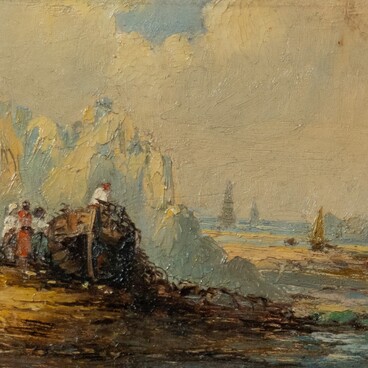The tradition of decorating offices and halls with portraits of emperors appeared in the times of Peter the Great. As a rule, portraits created by renowned painters would later serve as a standard to make copies from. Such copies could be used in offices and noble houses.
The museum’s collection contains a portrait of Empress Elizabeth Alexeievna — a copy made from the original by Jean-Laurent Mosnier, created in 1807. Nowadays, this portrait is kept in the State Russian Museum in St. Petersburg.
The artist’s manner of painting is characteristic of late classicism with its ceremonial painting traditions. The people depicted in Mosnier’s paintings have an air of grandeur about them. The portrait of Empress Elizabeth Alexeievna highlights her royal status. Her position is rather static: such theatrical “staged posing” in the style of antiquity was popular during the reign of Alexander I.
The original portrait was created by Jean-Laurent Mosnier, who was born in 1743 in Paris. In 1776, he was appointed court painter to Louis XVI, and at the court, Mosnier painted portraits of Queen Marie Antoinette. In 1788, he was elected a full member of the French Academy of Arts for the portraits of the sculptor Pierre-Charles Bridan and the painter Louis-Jean-François Lagrenée.
Mosnier emigrated from the country during the French Revolution. First, he arrived in England, then in Germany, and four years later in Russia. In St. Petersburg, he painted portraits of high society members: Empress Elizabeth, the Stroganov family, novelist August Heinrich Lafontaine, astronomer and politician Jean Sylvain Bailly, Prince Alexander Naryshkin, Admiral Baron George Rodney, and other people of influence. In 1802, Mosnier became an academician of the Imperial Academy of Arts, and four years later he was given the title of professor. The artist died in St. Petersburg in 1808.
Nowadays, Mosnier’s portraits are spread throughout the world. They can be found in museums and private collections in France, Canada, Great Britain, Germany, Spain, Russia, and the USA.
The museum’s collection contains a portrait of Empress Elizabeth Alexeievna — a copy made from the original by Jean-Laurent Mosnier, created in 1807. Nowadays, this portrait is kept in the State Russian Museum in St. Petersburg.
The artist’s manner of painting is characteristic of late classicism with its ceremonial painting traditions. The people depicted in Mosnier’s paintings have an air of grandeur about them. The portrait of Empress Elizabeth Alexeievna highlights her royal status. Her position is rather static: such theatrical “staged posing” in the style of antiquity was popular during the reign of Alexander I.
The original portrait was created by Jean-Laurent Mosnier, who was born in 1743 in Paris. In 1776, he was appointed court painter to Louis XVI, and at the court, Mosnier painted portraits of Queen Marie Antoinette. In 1788, he was elected a full member of the French Academy of Arts for the portraits of the sculptor Pierre-Charles Bridan and the painter Louis-Jean-François Lagrenée.
Mosnier emigrated from the country during the French Revolution. First, he arrived in England, then in Germany, and four years later in Russia. In St. Petersburg, he painted portraits of high society members: Empress Elizabeth, the Stroganov family, novelist August Heinrich Lafontaine, astronomer and politician Jean Sylvain Bailly, Prince Alexander Naryshkin, Admiral Baron George Rodney, and other people of influence. In 1802, Mosnier became an academician of the Imperial Academy of Arts, and four years later he was given the title of professor. The artist died in St. Petersburg in 1808.
Nowadays, Mosnier’s portraits are spread throughout the world. They can be found in museums and private collections in France, Canada, Great Britain, Germany, Spain, Russia, and the USA.


